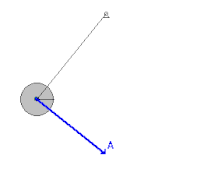Mechanical Energy is the sum total of both Potential Energy and Kinetic Energy present in a mechanical system. In a mechanical system the amount of mechanical energy is a constant. This equilibrium is only possible only in the presence of conservative forces like gravity and absence of non conservative forces like friction. Friction forces a body to use more energy to over come it and thus the energy is lost in the form of heat. More precisely in elastic collisions, the mechanical energy is conserved but in inelastic collisions, some mechanical energy is converted into heat. The equivalence between lost mechanical energy and an increase in temperature was discovered by James Prescott Joule.
Conservation and inter conversion of Energy:
Of the three great conservation laws of classical mechanics, the conservation of energy is regarded as the most important. According to this law, the mechanical energy of an isolated system remains constant in time, as long as the system is free of all frictional forces, including eventual internal friction from collisions of the objects of the system. In any real situation, frictional forces and other non-conservative forces are always present, but in many cases their effects on the system are so small that the principle of conservation of mechanical energy can be used as a fair approximation. Though energy cannot be created nor destroyed in an isolated system, it can be internally converted to any other form of energy.
Thus, in a mechanical system like a swinging pendulum subjected to the conservative gravitational force where frictional forces like air drag and friction at the pivot are negligible, energy passes back and forth between kinetic and potential energy but never leaves the system. The pendulum reaches greatest kinetic energy and least potential energy when in the vertical position, because it will have the greatest speed and be nearest the Earth at this point. On the other hand, it will have its least kinetic energy and greatest potential energy at the extreme positions of its swing, because it has zero speed and is farthest from Earth at these points. However, when taking the frictional forces into account, the system loses mechanical energy with each swing because of the work done by the pendulum to oppose these non-conservative forces.
That the loss of mechanical energy in a system always resulted in an increase of the system's temperature has been known for a long time, but it was the amateur physicist James Prescott Joule who first experimentally demonstrated how a certain amount of work done against friction resulted in a definite quantity of heat which should be conceived as the random motions of the particles that matter is composed of. This equivalence between mechanical energy and heat is especially important when considering colliding objects. In an elastic collision, mechanical energy is conserved; i.e. the sum of the kinetic energies of the colliding objects is the same before and after the collision. After an inelastic collision, however, the total mechanical energy of the system will have changed. Usually, the total mechanical energy after the collision is smaller than the initial total mechanical energy and the lost mechanical energy is converted into heat. However, the total mechanical energy can be greater after an inelastic collision if for example the collision causes an explosion which converts chemical energy into mechanical energy. In inelastic collisions, the smaller particles of which the colliding objects consist are shaken up and rattle around. These small-scale motions are perceived as an increase in heat and need kinetic energy which must be taken from the large-scale motion of the objects that are observed directly. Thus, the total energy of the system remains unchanged though the mechanical energy has been changed.










0 comments:
Post a Comment